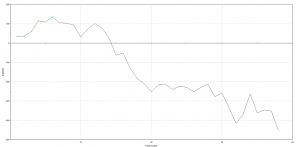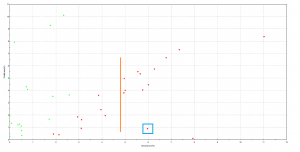by Guy Lerner, The Technical Take
I define the price cycle as the path prices take from low to high and back to low again. To help determine where I am in that cycle I use investor sentiment. Typically, extremes in bearish sentiment often define cycle low points leading to bullish gains, and extremes in bullish sentiment often define cycle high points leading to a loss of price momentum at best and more commonly, a retracement in price of the price move from low to high. This is the price cycle — “wash, rinse, repeat”.
The most recent bullish price cycle hit a low on October 7, 2011 and it did not peak out until April 20, 2012. Since April 20, 2012, the market (i.e., SP500) has sold off a little bit and has bounced little bit, but prices are still below the sell point. We are at that point in the price cycle where the bullish gains have been made and price momentum has been lost. We have yet to hit an extreme in bearish sentiment that would define a low point in the price cycle, and as I have stated for months now , the only way we can get there is to have lower prices. To understand what I am talking about, I will quantify these price dynamics.
So let’s create a study that looks at the part of the price cycle where upward price momentum has already slowed and prices have yet to hit a low point. In essence, what I am doing is looking at the part of the price cycle when prices are above the 200 day moving average and momentum has fallen out of the trend. For the study then, our buy signal occurs when the upward price thrust of the price cycle has ended and prices are above the 40 week moving average. Our sell signal is either new extremes in bearish sentiment (i.e., the bottom of the price cycle) or prices have closed below the 40 week moving average. What I want to know is what happens to price in the period after momentum of the upward thrust of the price cycles wanes to the next buy signal. This would replicate the current conditions in the market. The study is based upon the SP500 data starting in 1991.
Figure 1 shows the equity curve for this strategy, and it is not pretty. So once momentum of the initial price thrust is over, buying the market just because price is above its 40 week moving average is a poor idea.
Figure 1. Equity Curve

Figure 2 shows the maximum adverse excursion (MAE) graph. The MAE graph shows every trade from a particular strategy, and it is a measure of how much a trade moves adverse to its entry position. MAE is a measure of investor angst. For example, take the one trade inside the blue box. This trade had an MAE or draw down of 6% before being closed out for a 1% loss. We know it was a losing trade because the caret is red. Now look at the 13 red carets to the right of the orange line. This tells us that 13 out 38 total trades had an MAE greater 5%. In other words, if you buy at the top or when everyone else is bullish or when the upward initial price thrust has diminished, it is likely that you will experience an excessive draw down.
Figure 2. MAE Graph

There are several take away points here. Buying just because prices are above the 200 day moving average is a bad play. Momentum needs to be present. One way to have momentum develop is to have investors out of the market wanting in; these are the investors on the sidelines willing to pay up for prices. The best way to put investors on the sidelines is to have lower prices. Unfortunately, the problem with the current market is that it has not done a good job of putting investors on the sidelines as the persistent belief in the “Bernanke put” has put a floor under this market. Unfortunately, this dynamic is also responsible for the current listless price action. Furthermore, buying the market when prices are well above the 200 day moving average, which is usually when the pundits and TV analysts are signalling the all clear, is probably a poor idea most of the time.
From this perspective, the data from this study is consistent with the notion that we are in a range bound market at best or in a process where we need to see lower prices before heading meaningfully higher. The odds of success would be in your favor if you are buyer when others are bearish.












